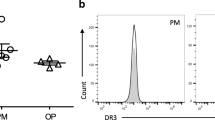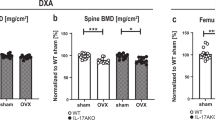Abstract
Summary
Presently the relationship between CD28, biological marker of senescence, and ovariectomy is not well understood. We show that ovariectomy leads to CD28 loss on T cells and estrogen (E2) repletion and medicarpin (Med) inhibits this effect. We thus propose that Med/E2 prevents bone loss by delaying premature T cell senescence.
Introduction
Estrogen deficiency triggers reproductive aging by accelerating the amplification of TNF-α-producing T cells, thereby leading to bone loss. To date, no study has been carried out to explain the relationship between CD4+CD28null T cells and ovariectomy or osteoporosis. We aim to determine the effect of Ovx on CD28 expression on T cells and effects of E2 and medicarpin (a pterocarpan phytoalexin) with proven osteoprotective effect on altered T cell responses.
Methods
Adult, female Balb/c mice were taken for the study. The groups were: sham, Ovx, Ovx + Med or E2. Treatments were given daily by oral gavage. At autopsy bone marrow and spleen were flushed out and cells labelled with antibodies for FACS analysis. Serum was collected for ELISA.
Results
In Ovx mice, Med/E2 at their respective osteoprotective doses resulted in thymus involution and lowered Ovx-induced increase in serum TNF-α level and its mRNA levels in the BM T cells. Med/E2 reduced BM and spleen CD4+ T cell proliferation and prevented CD28 loss on CD4+ T cells. Further, Med abrogated TNF-α-induced loss of CD28 expression in the BM T cells.
Conclusions
To our knowledge this is the first report to determine the mechanism of CD28 loss on T cells as a result of ovariectomy. Our study demonstrates that Ovx leads to the generation of premature senescent CD4+CD28null T cells, an effect inhibited by E2 and Med. We propose that one of the mechanisms by which Med/E2 alleviates Ovx-induced bone loss is by delaying T cell senescence and enhancing CD28 expression.






Similar content being viewed by others
References
Clowes JA, Riggs BL, Khosla S (2005) The role of the immune system in the pathophysiology of osteoporosis. Immunol Rev 208:207–227
Weitzmann MN, Pacifici R (2007) T cells: unexpected players in the bone loss induced by estrogen deficiency and in basal bone homeostasis. Ann N Y Acad Sci 1116:360–375
Rauner M, Sipos W, Pietschmann P (2007) Osteoimmunology. Int Arch Allergy Immunol 143:31–48
Ginaldi L, Di Benedetto MC, De Martinis M (2005) Osteoporosis, inflammation and ageing. Immun Ageing 2:14
De Martinins M, Mengoli LP, Ginaldi L (2007) Osteoporosis—an immune mediated disease? Drug Discov Today Ther Strat 4:3–9
Cenci S, Weitzmann MN, Roggia C, Namba N, Novack D, Woodring J et al (2000) Estrogen deficiency induces bone loss by enhancing T-cell production of TNF-alpha. J Clin Invest 106:1229–1237
Weitzmann MN, Pacifici R (2005) The role of T lymphocytes in bone metabolism. Immunol Rev 208:154–168
Pacifici R (2007) T cells and post menopausal osteoporosis in murine models. Arthritis Res Ther 9:102
D'Amelio P, Grimaldi A, Di Bella S, Brianza SZ, Cristofaro MA, Tamone C et al (2008) Estrogen deficiency increases osteoclastogenesis up-regulating T cells activity: a key mechanism in osteoporosis. Bone 43:92–100
Vallejo AN, Nestel AR, Schirmer M, Weyand CM, Goronzy JJ (1998) Aging-related deficiency of CD28 expression in CD4+ T cells is associated with the loss of gene-specific nuclear factor binding activity. J Biol Chem 273:8119–8129
Vallejo AN, Weyand CM, Goronzy JJ (2004) T cell senescense: a culprit of immune abnormalities in chronic inflammation and persistent infection. Trends Mol Med 10:119–124
Effros RB (1997) Loss of CD28 expression on T lymphocytes: a marker of replicative senescence. Dev Comp Immunol 21:471–478
Vallejo AN, Brandes JC, Weyand CM, Goronzy JJ (1999) Modulation of CD28 expression: distinct regulatory pathways during activation and replicative senescence. J Immunol 162:6572–6579
Vallejo AN, Bryl E, Klarskov K, Naylor S, Weyand CM, Goronzy JJ (2002) Molecular basis for the loss of CD28 expression in senescent T cells. J Biol Chem 277:46940–46949
Effros RB (1998) Replicative senescence: impact on T cell immunity in the elderly. Aging (Milano) 10:152
Effros RB, Boucher N, Porter V, Zhu X, Spaulding C, Walford RL et al (1994) Decline in CD28+ T cells in centenarians and in long-term T cell cultures: a possible cause for both in vivo and in vitro immunosenescence. Exp Gerontol 29:601–609
Bryl E, Vallejo AN, Weyand CM, Goronzy JJ (2001) Down-regulation of CD28 expression by TNF-alpha. J Immunol 167:3231–3238
Bryl E, Vallejo AN, Matteson EL, Witkowski JM, Weyand CM, Goronzy JJ (2005) Modulation of CD28 expression with anti-tumor necrosis factor alpha therapy in rheumatoid arthritis. Arthritis Rheum 52:2996–3003
Hertrampf T, Gruca MJ, Seibel J, Laudenbach U, Fritzemeier KH, Diel P (2007) The bone-protective effect of the phytoestrogen genistein is mediated via ER alpha-dependent mechanisms and strongly enhanced by physical activity. Bone 40:1529–1535
Bitto A, Polito F, Burnett B, Levy R, Di Stefano V, Armbruster MA et al (2009) Protective effect of genistein aglycone on the development of osteonecrosis of the femoral head and secondary osteoporosis induced by methylprednisolone in rats. J Endocrinol 201:321–328
Tyagi AM, Gautam AK, Kumar A, Srivastava K, Bhargavan B, Trivedi R et al (2010) Medicarpin inhibits osteoclastogenesis and has nonestrogenic bone conserving effect in ovariectomized mice. Mol Cell Endocrinol 325:101–109
Cenci S, Toraldo G, Weitzmann MN, Roggia C, Gao Y, Qian WP et al (2003) Estrogen deficiency induces bone loss by increasing T cell proliferation and lifespan through IFN-gamma-induced class II transactivator. Proc Natl Acad Sci U S A 100:10405–10410
Baker PJ, Dixon M, Evans RT, Dufour L, Johnson E, Roopenian DC (1999) CD4(+) T cells and the proinflammatory cytokines gamma interferon and interleukin-6 contribute to alveolar bone loss in mice. Infect Immun 67:2804–2809
Tarjanyi O, Boldizsar F, Nemeth P, Mikecz K, Glant TT (2009) Age-related changes in arthritis susceptibility and severity in a murine model of rheumatoid arthritis. Immun Ageing 6:8
Kozlowska E, Biernacka M, Ciechomska M, Drela N (2007) Age-related changes in the occurrence and characteristics of thymic CD4(+) CD25(+) T cells in mice. Immunology 122:445–453
Pandey R, Gautam AK, Biju B, Trivedi R, Swarnkar G, Nagar GK, Yadav DK, Kumar M, Rawat P, Manickavasagam L, Maurya R, Goel A, Jain GK, Chattopadhyay N, Singh D (2010) Total extract and standardized fraction from the stem bark of Butea monosperma have osteoprotective action: evidence for the non-estrogenic osteogenic effect of the standardized fraction. Menopause 17:602–610
Miyamoto M, Matsushita Y, Kiyokawa A, Fukuda C, Iijima Y, Sugano M et al (1998) Prenylflavonoids: a new class of non-steroidal phytoestrogen (part 2). Estrogenic effects of 8-isopentenylnaringenin on bone metabolism. Planta Med 64:516–519
Bianchi F, Bernardini N, Marchetti P, Navalesi R, Giannarelli R, Dolfi A et al (1993) In vitro morpho-functional analysis of pancreatic islets isolated from the domestic chicken. Tissue Cell 25:817–824
Marchetti P, Giannarelli R, Villani G, Andreozzi M, Cruschelli L, Cosimi S et al (1994) Collagenase distension, two-step sequential filtration, and histopaque gradient purification for consistent isolation of pure pancreatic islets from the market-age (6-month-old) pig. Transplantation 57:1532–1535
Erlandsson MC, Gomori E, Taube M, Carlsten H (2000) Effects of raloxifene, a selective estrogen receptor modulator, on thymus, T cell reactivity, and inflammation in mice. Cell Immunol 205:103–109
Banfi G, Iorio EL, Corsi MM (2008) Oxidative stress, free radicals and bone remodeling. Clin Chem Lab Med 46:1550–1555
Grassi F, Tell G, Robbie-Ryan M, Gao Y, Terauchi M, Yang X et al (2007) Oxidative stress causes bone loss in estrogen-deficient mice through enhanced bone marrow dendritic cell activation. Proc Natl Acad Sci U S A 104:15087–15092
Roggia C, Gao Y, Cenci S, Weitzmann MN, Toraldo G, Isaia G et al (2001) Up-regulation of TNF-producing T cells in the bone marrow: a key mechanism by which estrogen deficiency induces bone loss in vivo. Proc Natl Acad Sci U S A 98:13960–13965
Mundy GR (2007) Osteoporosis and inflammation. Nutr Rev 65:S147–S151
Rijhsinghani AG, Thompson K, Bhatia SK, Waldschmidt TJ (1996) Estrogen blocks early T cell development in the thymus. Am J Reprod Immunol 36:269–277
Franco P, Marelli O, Lattuada D, Locatelli V, Cocchi D, Muller EE (1990) Influence of growth hormone on the immunosuppressive effect of prednisolone in mice. Acta Endocrinol (Copenh) 123:339–344
Lean JM, Davies JT, Fuller K, Jagger CJ, Kirstein B, Partington GA et al (2003) A crucial role for thiol antioxidants in estrogen-deficiency bone loss. J Clin Invest 112:915–923
Sun D, Krishnan A, Zaman K, Lawrence R, Bhattacharya A, Fernandes G (2003) Dietary n-3 fatty acids decrease osteoclastogenesis and loss of bone mass in ovariectomized mice. J Bone Miner Res 18:1206–1216
Rosen CJ, Usiskin K, Owens M, Barlascini CO, Belsky M, Adler RA (1990) T lymphocyte surface antigen markers in osteoporosis. J Bone Miner Res 5:851–855
Imanishi T, Hano T, Nishio I (2005) Estrogen reduces angiotensin II-induced acceleration of senescence in endothelial progenitor cells. Hypertens Res 28:263–271
Ma S, Ochi H, Cui L, Zhang J, He W (2003) Hydrogen peroxide induced down-regulation of CD28 expression of Jurkat cells is associated with a change of site alpha-specific nuclear factor binding activity and the activation of caspase-3. Exp Gerontol 38:1109–1118
Somjen D, Katzburg S, Sharon O, Grafi-Cohen M, Knoll E, Stern N (2011) The effects of estrogen receptors alpha- and beta-specific agonists and antagonists on cell proliferation and energy metabolism in human bone cell line. J Cell Biochem 112(2):625–632
Acknowledgments
Funding from the Ministry of Health and Family Welfare and Department of Science and Technology, Government of India is acknowledged. AMT, AK, AR, and DKY are thankful to the Council of Scientific and Industrial Research for fellowship grants. We deeply acknowledge Mr Vishwakarma for hel** us in the FACS analysis. We pay our sincere thanks to Dr Naibedya Chattopadhyay for going through our manuscript and his valuable suggestions have helped us improve the manuscript.
Conflicts of interest
None.
Author information
Authors and Affiliations
Corresponding author
Additional information
Supporting grants are from the Ministry of Health and Family Welfare, Council of Scientific and Industrial Research, University Grants Commission, and the Government of India. CDRI communication manuscript number 158/2010/DS.
Electronic supplementary material
Below is the link to the electronic supplementary material.
Supplemental Table 1
(PPT 34 kb)
Supplementary Fig. 1
(PPT 95 kb)
Supplementary Fig. 2
(PPT 118 kb)
Supplementary Fig. 3
(PPT 133 kb)
Rights and permissions
About this article
Cite this article
Tyagi, A.M., Srivastava, K., Kureel, J. et al. Premature T cell senescence in Ovx mice is inhibited by repletion of estrogen and medicarpin: a possible mechanism for alleviating bone loss. Osteoporos Int 23, 1151–1161 (2012). https://doi.org/10.1007/s00198-011-1650-x
Received:
Accepted:
Published:
Issue Date:
DOI: https://doi.org/10.1007/s00198-011-1650-x




